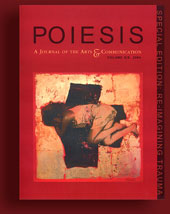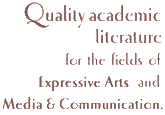
POIESIS VI
A Journal of the Arts & Communication

This special issue on trauma and the arts is entitled “Re-Imagining Trauma.” From psychoanalyst Michael Eigen to philosopher Jean-Luc Nancy, exploring both intimately personal experience as well as wide theoretical perspectives, this sixth annual issue of POIESIS intelligently and critically looks at trauma and art-making from the varied perspectives of Expressive Arts Therapy and Media and Communication, as well as from their places of overlap. More poetry and artwork are in this issue than ever before, and we’ve made a jump to a 100% glossy interior!
$10.95 Cdn
/ $10.95 US
ISBN 14924986
Order Details:
You can order POIESIS VI by email. We generally can accept payment by visa card. Alternatively you can send a personalized cheque through the mail. Please send us your address information and the name(s) of the items you are interested in. We will let you know the postage.
Editor’s Introduction to POIESIS VI, by Stephen K. Levine
Is this The Age of Trauma? Sometimes it seems we speak of nothing else. Trauma fixes our gaze; we are caught in its Medusa stare, petrified, immobilized, unable to escape the memories which repeat themselves: insistent, involuntary, unvarying. Always the same: the camps, the bomb. We name them: Auschwitz, Hiroshima. Yet, have we said anything at all with these names? Are they empty signifiers that take away the horror? How can we speak of the unspeakable?
Trauma forbids representation, or so Adorno implied in his famous statement, “To write poetry after Auschwitz is barbaric.” But to name the unnameable is already to take on the responsibility of language. Our task then becomes to speak in a way that does justice to that of which one cannot speak. What kind of language can carry out that task? Perhaps only a language that carries an awareness of its own difference from that which it designates. A poetry (and by “poetry” we mean all forms of artistic representation) that gives up the attempt to become the Real but rather recognizes itself as artificial, as art. Such poiesis knows that memory is always already imagination, that there is no way to overcome the past except to see it anew.
This special issue of POIESIS, co-edited by Paul Antze and myself, is dedicated to the theme of re-imagining trauma, of finding new perspectives on suffering and the practice of the arts. We begin with a reflection by Jean-Luc Nancy on the very prohibition of representation that trauma presents to us. Yet this forbidding aspect, Nancy reminds us, is also a command to pause, to reflect and to respond. Trauma is forbidding; it startles and shocks us, making us approach it, if we dare, with awe. When we do, we realize that it is not the trauma that prohibits representation; rather it is the attempt to prohibit representation that has produced the most awful of traumas. Thus the Nazis wanted to be the Real, not to represent it. The extermination of the Jews was an attempt to eliminate those who were seen as the bearers of representation, those who had no place, no fixed identity rooted in a homeland. Only a representation which puts into play the un-representability of the camps, the “crushing of sense at Auschwitz,” Nancy suggests, can do justice to the horror.
What kind of representation can this be? For Joseph Rosen, in “Lunch with the F�hrer,” it is not tragedy but comedy that is an appropriate response to the Shaoh today—not an easy laughter that makes fun of the enemy, but the barbaric revolt that proclaims his entry into the very gates of the self. To Brigitte Anor, we are already “image-bearers”; we carry the memory of trauma and are capable of exposing its trace through our artwork. Such an artist is Bracha Ettinger, whose work recalls trauma by erasing it, leaving only the marks of its absence. Trauma, Ettinger tells us, is indeed traced inside us, in a “matrixial borderspace” that is the potential birthplace of art.
Michael Eigen’s patient, Arnie, says, “I’m the trauma,” meaning, to Eigen, “…the advent of I, the process of I-ing.” The work of the therapist is to be with the trauma, to help dissolve the “trauma clots” by being together with the patient, to do “what we can.” Being together with, for Karen Hawkins, means bearing witness to those who have suffered—in this case, the Vancouver women missing and brutally murdered. “Beauty,” she says, is to be found “in the art of witness.” For Rishma Dunlop, the “literature of witness” takes her and her students into the terror of Rwanda in order to “…understand education as a location for beauty…reminding us of our human capacity to rise out of grief, singing…”
We are called to witness, even as we know that we can never, in Saara Liinamaa’s words, “…speak about the disaster—only the moment after, the disaster’s slips and traces…” In the exhibits commemorating September 11 and the Holocaust that she discusses, we see both the limits of representation and the obligation we have to continue to look at the catastrophe that has occurred. We can see—or better, touch—it, Anna Liv Issacsson suggests in her interpretation of the film, Hiroshima, mon amour, only by accepting the “deferral of trauma,” a space between the event and its representation that is perhaps also the space between oneself and other.
In this space, the possibility arises of seeing it differently. For Lila Pine, this can be an act of “storyliving,” suggested by the way her “mad” Aunt Lila’s story could be told from multiple points of view. Here memory is explicitly seen as an imaginative act; we are not only subject to trauma but have the possibility of transforming it. In this way, Laura Martin tells us what she made of her blindness, how poiesis helped her to see through touch. Rebekah Windmiller, for her part, found that even the acute psychiatric patients of a locked ward could be moved by the “surprise within repetition” first discovered in the algorithmic pattern of a dance. And Melinda Meyer, in her work with traumatized refugees in exile in Norway, saw that the “literal trauma story” had to be abandoned and told in multiple expressive ways in order for the person to be taken “out of isolation” and given “…a sense of being seen and touched by another.” These “reflective protoconversations,” Rosemary Faire tells us in her review of Russell Meares’ book on trauma, elide literal recall. Instead they result in “flights” of the imagination which need to be grounded in the “perchings” of sensorial expression. Thus even the traumatized body can be affected by poiesis.
Consideration of the body suggests not only themes of pain and death but also pleasure and love. Alain Badiou, in our last article, asks whether contemporary nihilism can be overcome by means of sexual enjoyment (jouissance). For Badiou, such ecstasy must be deferred; nihilism, the experience of the meaninglessness of the world, can be overcome not by an empty, repetitive pursuit of pleasure but only through the making of a world in which all those who are excluded are named and recognized. Our poems and images must therefore “…fulfill none of the desires we are a slave to, but…name the future bearers of liberty.”
We begin with trauma and end with joy. Perhaps these phenomena need to be thought together. In different ways, each takes us out of ourselves and renders representation both impossible and necessary at the same time. In the end, both require a new form of language, a way of speaking that gives up the attempt to master the Real. To paraphrase Badiou, we could say that we create by fragments a poiesis without fetishes, not even, above all, the fetish of poiesis. This would be barbarism indeed. And perhaps the barbarians are the very “future bearers of liberty” whom we must name in our poems.
I sound my barbaric yawp over the roofs of the world.
—Walt Whitman
